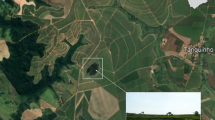Abstract
The purpose of this study was to track the refuse profile in Lorong Halus Dumping Ground, the largest landfill in Singapore, by electrical resistivity and surface wave velocity after 25 years of closure. Data were analyzed using an orthogonal set of plots by spreading 24 lines in two perpendicular geophone-orientation directions. Both geophysical techniques determined that refuse boundary depth was 13 ± 2 m. The refuse boundary revealed a certain degree of variance, mainly ascribed to the different principle of measurements, as well as the high heterogeneity of the subsurface. Discrepancy was higher in spots with greater heterogeneity. 3D analysis was further conducted detecting refuse pockets, leachate mounding and gas channels. Geotechnical monitoring (borehole) confirmed geophysical outcomes tracing different layers such as soil capping, decomposed refuse materials and inorganic wastes. Combining the geophysical methods with borehole monitoring, a comprehensive layout of the dumping site was presented showing the hot spots of interests.





Similar content being viewed by others
References
Abdullah NK, Osazuwa IB, Sule PO (2011) Application of integrated geophysical techniques in the investigation of groundwater contamination: a case study of municipal solid waste leachate. Ozean J Appl Sci 4:7–25
Abu-Zeid N, Bianchini G, Santarato G, Vaccaro C (2004) Geochemical characterisation and geophysical mapping of landfill leachates: the Marozzo canal case study (NE Italy). Environ Geol 45:439–447
Al-Tarazi E, El-Naqa A, EI-Waheidi M, Rajab JA (2006) Electrical geophysical and hydrogeological investigations of groundwater aquifers in Ruseifa municipal landfill, Jordan. Environ Geol 50:1095–1103
Balia R, Littarru B (2010) Geophysical experiments for the pre-reclamation assessment of industrial and municipal waste landfills. J Geophys Eng 7:64–74
Bentley LR, Gharibi M (2004) Two- and three-dimensional electrical resistivity imaging at a heterogeneous remediation site. Geophysics 69:674–680
Brunet P, Clement R, Bouvier C (2010) Monitoring soil water content and deficit using electrical resistivity tomography (ERT)—a case study in the Cevennes area, France. J Hydrol 380:146–153
CPG Consultants (2005) Tampines and Lorong Halus landfill sites environmental site characterization study. Public Utilities Board (PUB), Water Department, Singapore
Dahlin T, Bernstone C, Loke MH (2002) A 3-D resistivity investigation of a contaminated site at Lernacken, Sweden. Geophysics 67:1692–1700
Djadia L, Machane D, Chatelain JL, Abtout A, Bensalem R, Guemache MA, Guillier B, Boudella A, Oubaiche EIH (2010) Evidence for an underground runoff and soil permeability at the Ouled Fayet (Algiers, Algeria) subsurface landfill pilot project from geophysical investigations. Environ Earth Sci 59:1149–1158
Environmental Protection Agency (EPA) (2002) Technical approaches to characterizing and redeveloping brownfields sites: municipal landfills and illegal dumps. Cincinnati, EPA/625/R-02/002
Grellier S, Reddy K, Gangathulasi J, Adib R, Peters C (2007) Correlation between electrical resistivity and moisture content of municipal solid waste in bioreactor landfill. ASCE Geotechnical Special Publication No.163. ASCE Press, Reston
Hebeler GL, Rix GJ (2001) Site characterization in Shelby County, Tennessee using advanced surface wave methods. Report to the Mid-American Earthquake Centre, Georgia Institute of Technology, Atlanta
Holcombe HT, Jiracek GR (1984) Three-dimensional terrain corrections in resistivity surveys. Geophysics 49:439–452
Lee KW, Zhou Y (2009) Geology of Singapore, 2nd edn. Defense Science and Technology Agency, Singapore, p 90
Loke MH, Barker RD (1996) Practical techniques for 3D resistivity surveys and data inversion. Geophys Prospect 44:499–523
Lopes DD, Silva SMCP, Fernandes F, Teixeira RS, Celligoi A, Dall’Antonia LH (2012) Geophysical technique and groundwater monitoring to detect leachate contamination in the surrounding area of a landfill—Londrina (PR—Brazil). J Environ Manag 113:481–487
Martinho E, Almeida F (2006) 3D behaviour of contamination in landfill sites using 2D resistivity/IP imaging: case studies in Portugal. Environ Geol 49:1071–1078
Meinhardt (2004) Feasibility study on the rehabilitation of Lorong halus landfill for industrial development. Meinhardt Infrasturcture and Environment Pte Ltd, Singapore
Reddy KR, Grellier S, Carpenter P, Bogner J (2009) Geophysical monitoring of leachate recirculation at Orchard Hills landfill. Department of Civil and Materials Engineering, University of Illinois at Chicago, Chicago
Samouëlian A, Richard G, Cousin I, Guérin R, Bruand A, Tabbagh A (2004) Three-dimensional crack monitoring by electrical resistivity measurement. Eur J Soil Sci 55:751–762
Watson DB, Doll WB, Gamey TJ, Sheenhan JR, Jardine PM (2005) Plume and lithologic profiling with surface resistivity and seismic tomography. Groundwater 43:169–177
Yoon JY, Lee KL, Kwon B, Han W (2003) Geoelectrical surveys of the Nanjido waste landfill in Seoul, Korea. Environ Geol 43:654–666
Acknowledgments
This study is supported by the National Research Foundation, Singapore; Program Number NRF-CRP5-2009-02, for the School of Civil and Environmental Engineering/Residues and Resource Reclamation Centre, Nanyang Technological University, Singapore.
Author information
Authors and Affiliations
Corresponding author
Rights and permissions
About this article
Cite this article
Yin, K., Tong, H.H., Noh, O. et al. Mapping Refuse Profile in Singapore Old Dumping Ground through Electrical Resistivity, S-Wave Velocity and Geotechnical Monitoring. Bull Environ Contam Toxicol 94, 275–281 (2015). https://doi.org/10.1007/s00128-014-1427-y
Received:
Accepted:
Published:
Issue Date:
DOI: https://doi.org/10.1007/s00128-014-1427-y




